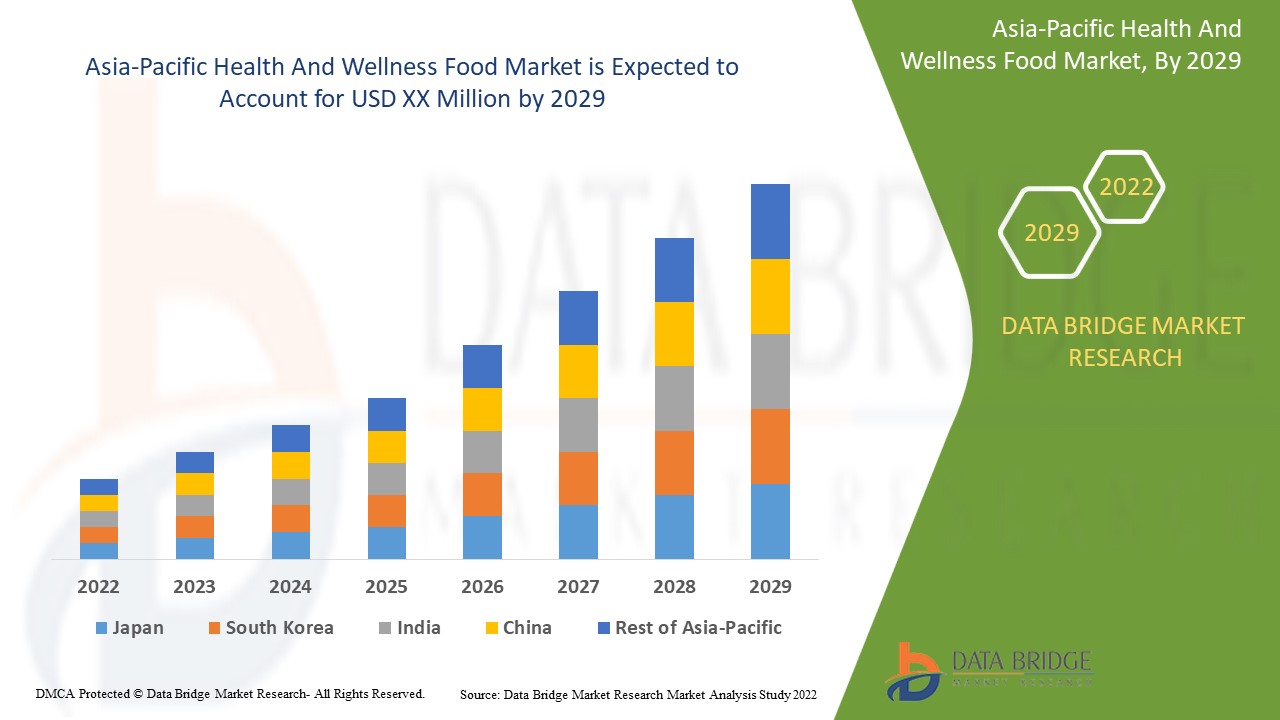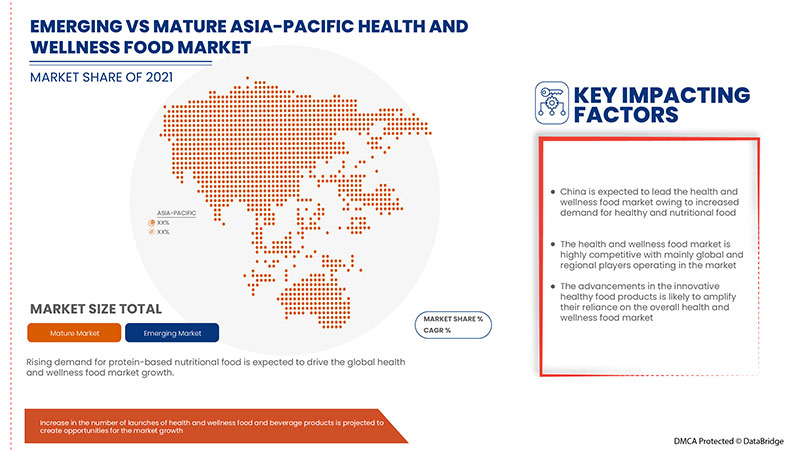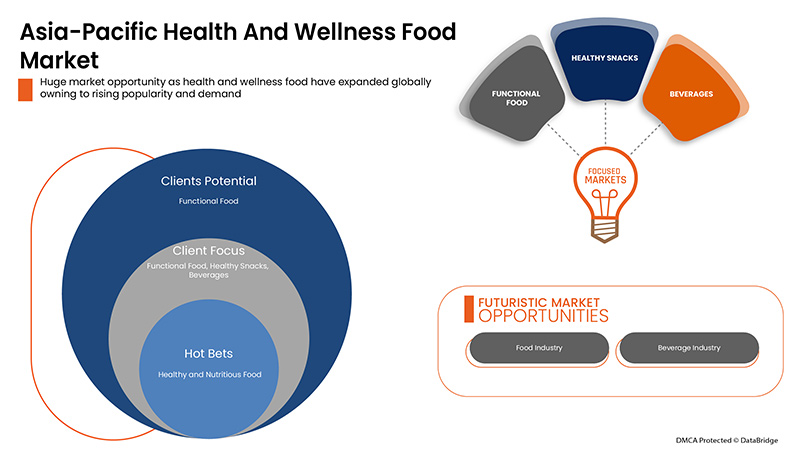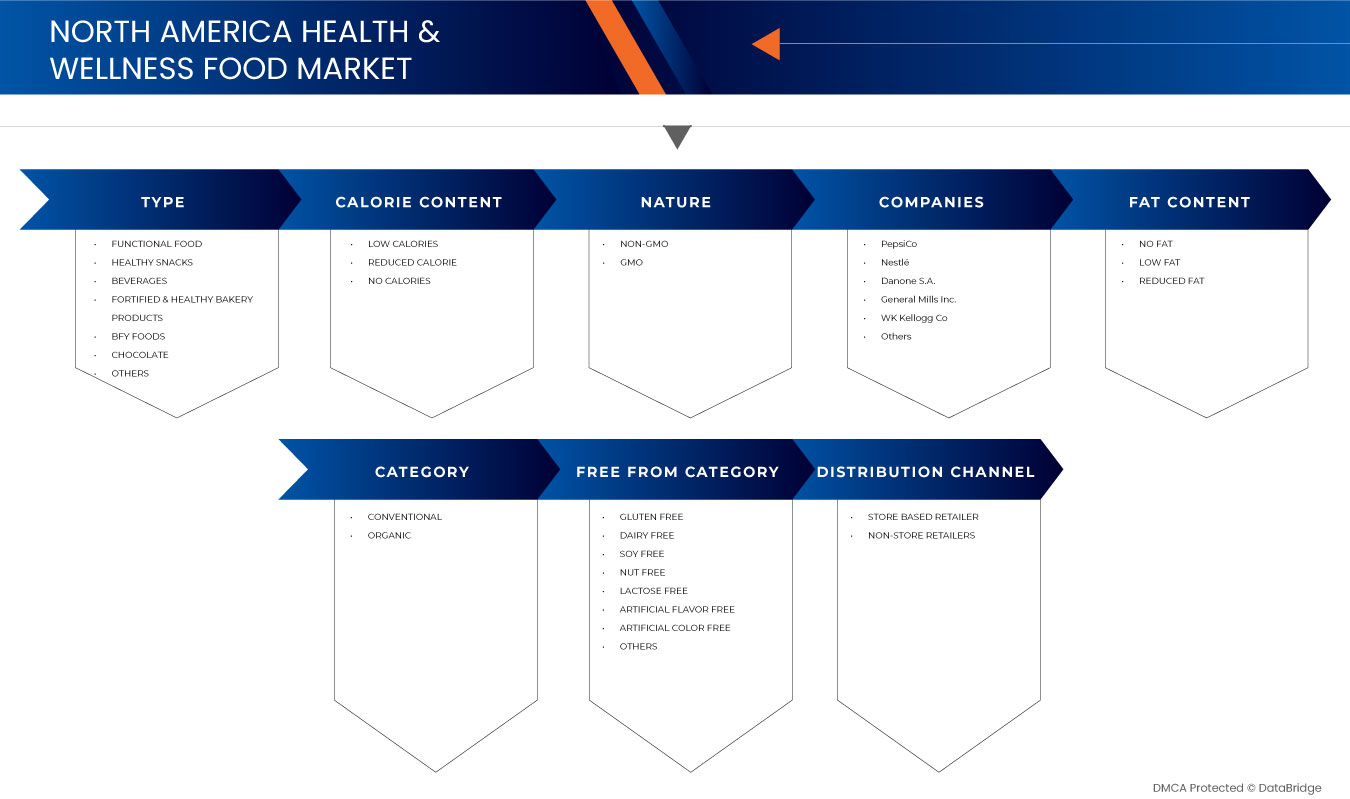Asia-Pacific Health and Wellness Food Market, By Type (Functional Food, Fortified and Healthy Bakery Products, Healthy Snacks, BFY Foods, Beverages, Chocolates and Others), Calorie Content (No-Calorie, Low Calories and Reduced-Calorie), Nature (Non-GMO and GMO), Fat Content (No Fat, Low Fat and Reduced-Fat), Category (Conventional and Organic), Free From Category (Gluten-Free, Dairy-Free, Soy-Free, Nut-Free, Lactose-Free, Artificial Flavor-Free, Artificial Color-Free and Others) and Distribution Channel (Store-Based Retailers and Non-Store Retailers) Industry Trends and Forecast to 2029

Market Analysis and Insights
Asia-Pacific health and wellness food market is gaining significant growth due to the growing food & beverage industry and the rise in demand for healthy and nutritional food products. The increase in the number of health conscious people is also boosting the growth of Asia's Pacific health and wellness food market. However, stringent government regulations associated with food products are expected to restrain the market growth of the vanilla market during the forecast period.


For instance,
- In August 2019, according to Economics Times, Danone and Nestle, two European food titans, pushed up new product releases and developments, a formula for fighting off new competition in the health and nutrition industry. While Nestle is relaunched Milo, the world's largest malted food drinks brand, Danone said it is working on over a dozen new products, including low sugar variations, bar, and ready-to-drink versions of its health brand Protinex
Data Bridge Market Research analyses that the Asia-Pacific health and wellness food market will grow at a CAGR of 9.9% during the forecast period of 2022 to 2029.
|
Report Metric |
Details |
|
Forecast Period |
2022 to 2029 |
|
Base Year |
2021 |
|
Historic Year |
2020 (Customizable to 2019- 2015) |
|
Quantitative Units |
Revenue in USD Billion |
|
Segments Covered |
By Type (Functional Food, Fortified and Healthy Bakery Products, Healthy Snacks, BFY Foods, Beverages, Chocolates and Others), Calorie Content (No-Calorie, Low Calories and Reduced-Calorie), Nature (Non-GMO and GMO), Fat Content (No Fat, Low Fat and Reduced-Fat), Category (Conventional and Organic), Free From Category (Gluten-Free, Dairy-Free, Soy-Free, Nut-Free, Lactose-Free, Artificial Flavor-Free, Artificial Color-Free and Others) and Distribution Channel (Store-Based Retailers and Non-Store Retailers) |
|
Regions Covered |
China, Japan, Australia, India, Philippines, Indonesia, Singapore, South Korea, Malaysia, Thailand and rest of Asia-Pacific |
|
Market Players Covered |
Alter Eco, Maspex, PepsiCo, General Mills Inc., Mars, Incorporated, Nestlé, Danone, Abbott, Huel Inc., GSK Group of Companies, Clif Bar & Company, Green Valley Dairies, Chobani, LLC., SO DELICIOUS DAIRY FREE, Enjoy Life, The Simply Good Foods Company, Mondelez International. , Kellogg Co., The Quaker Oats Company, and Yakult Honsha Co., Ltd. |
Market Definition
Food, health, and wellness are all interconnected. The food we consume and where it comes from impact our health and fitness. Wellness stems from the balanced food we incorporate into our daily lives. Health is not just eating better foods but also lowering tension and stress and exercising regularly. Food, Health, and Well-Being foods can help reduce the risk or treatment of disease and improve physical or mental performance by including a functional element or a modification in processing.
Asia-Pacific Health And Wellness Food Market Dynamics
Drivers
- Rising demand for protein-based nutritional and healthy food & beverages
There is a rapid demand for protein-based, healthy food and beverages as consumers have become more health-conscious and prefer food with more nutritional value and health benefits that will help them maintain a healthy diet.
Nuts, cereals, grains, fruits, and vegetables, are important protein sources used to produce protein-based food products. Thus, manufacturers focus on new product developments by bringing various blends of nuts, fruits, grains, cereal-based snacks, bars, beverages, and others high in protein to attract the consumer base.
Moreover, protein is one of the major macronutrients our body needs in a large quantity to function properly. Protein is an important substance that is needed by every body cell. Protein is the main element for nails and hair and also plays an important role for skin and body, as it builds and repairs tissues. It is also essential for bones, muscles, and blood. Thus, manufacturers are making efforts to introduce protein-rich food into the market.
Additionally, protein-based beverages provide better nourishment as it contains a high amount of protein and other beneficial nutrients; thus, being a protein-rich source, they boost energy and nourish the body to a greater extent. Furthermore, protein-based provides stronger health, superior taste, and more refreshment. Moreover, protein furnishes the body with muscles, organs, hair, tissues, and skin. Protein-based nutritional beverages also play a role in metabolism, weight loss, and weight management, helping drive fat release, lessening fat storage, and increasing the body's metabolic rate. Consumers are aware of this fact, thus, demanding more protein-based food & beverages products worldwide.
- Increasing disposable income and growing expenditure on healthy food products
An increase in disposable income or high disposable income across the world enables consumers to afford more food & beverages.
Furthermore, when disposable income increases, households have more money to either save or spend on food, which naturally leads to a growth in consumption of healthy food products, creating demand for the global health and wellness food market. Thus, increasing the disposable income of consumers enables them to buy more nutritional beverages to live a healthy life, boosting the market growth.
Furthermore, increasing expenditure on healthy and nutritional food has driven the demand for food products that help people maintain their health.
Thus, it can be seen that due to the increase in disposable income, consumers spend more money on healthy products such as nutritional beverages to stay healthy, which is expected to drive the growth of the global health and wellness food market.
Opportunities
-
Increase in number of launches of health and wellness food & beverage products
The health and wellness market is growing rapidly worldwide due to increased health awareness and demand for healthy and nutritional products.
An important part of the launch plan is quickly validating the product and its benefits. This is done using the Net Promoter Score (NPS), and the Customer Satisfaction Score (CSAT) can be corrupted when you get negative feedback from users who are not meant to test the first version of your product or feature. This way, manufacturers of health and wellness food consistently create new launch strategies, which helps the company grow.
For instance,
-
In July 2021, according to the PR News Wire, Health-Ade, a U.S. brand, launched "Pop," a prebiotic soda with low sugar and real gut health benefits, completing a gut-healthy beverage portfolio. The better-for-you soda comes in new packaging, flavors, and formulas, for a total of six delectable options: Pomegranate Berry, Lemon Lime, Ginger Fizz, Strawberry Vanilla, Apple Snap, and Juicy Grape are some of the flavors available
Thus, the new launch strategies are applied to drive the market. This is an outstanding opportunity for manufacturers as these launches explain the content and quality of the products, enabling consumers to buy healthier products.
Restraints/Challenges
- Lack of awareness among people and skepticism towards healthy food & beverages
The limited or lack of awareness about the health benefits and nutritional value of nutritional food & beverages creates skepticism about the products. Consumers are hesitant about consuming nutritional beverages due to increased contamination and adulteration in food & beverages. Thus, this ultimately creates skepticism among the consumers, who think twice before buying the food or beverage to avoid the side effects. This is the key challenging factor for the market growth. Lack of understanding about nutritional labeling on food & beverages creates confusion among consumers. The nutritional labels can be misleading, and in some cases, these are false claims, creating hesitation among consumers to choose proper healthy food & beverages.
- Higher prices of healthy nutritional food & beverages
Fluctuating prices of raw materials and higher prices for a better quality of nutrients resulted in increased costs of nutritional food &beverages. Additionally, higher food taxes and growing demand for nutritional food & beverages result in high prices.
High prices of these products may change purchase patterns for consumers, such as medium-sugar drinks, nutritional shakes, sports drinks, energy drinks, and other beverages that restrict the price-sensitive consumers from buying such products.
For instance,
- The average price of Altrajuice Apple is $4.75/200 ml; however, the average price of a Coke/Pepsi is US$ 2.50/ 330 ml
Thus, due to the high prices of healthy, nutritional food & beverages, consumers may shift towards more affordable substitutes for the lower middle class and middle class, restraining the growth of the global health and wellness food market.
Post COVID-19 Impact On Asia-Pacific Health And Wellness Food Market
Post the pandemic, the demand for health and food products has increased as there won't be any restrictions on movement; hence, the supply of products would be easy. In addition, the growing trend of a healthy diet and the increased number of health-conscious people worldwide after the coronavirus outbreak are expected to drive the market's growth.
The increased demand for fortified and healthy, protein-rich, nutritional food & beverages enables manufacturers to launch innovative new healthy snacking options, ultimately increasing the demand for health and wellness food, which has helped the market grow.
For instance,
- In December 2020, DuPont announced the development of a new ingredient line called Virslik, a processing aid with a 'desirable texture' and a 'clean flavor.' This ingredient will help formulate yogurt with new flavors and textures.
Recent Developments
- In October 2020, according to the Food Business, KIND Healthy Snacks elevated its energy bar category by launching the KIND Energy bar, a bar that offers sustained energy from whole grains. The bar is made from oats and contains 35% less sugar
- In May 2022, according to Food Business, Oreo is launching a new range of gluten-free Oreos in the United States, Oreo Zero in China, Lacta Intense in Brazil, and Caramilk, a chocolate product, in Australia. These products result from new formulations for health-conscious consumers as health and well-being continue to be a focus of innovation for the company
Asia-Pacific Health And Wellness Food Market Scope
Asia-Pacific health and wellness food Market is segmented into seven notable segments based on type, calorie content, nature, fat content, category, free form category, and distribution channel.
The growth amongst these segments will help you analyze major growth segments in the industries and provide the users with a valuable market overview and market insights to make strategic decisions to identify core market applications.
Type
- Functional Food
- Healthy Snacks
- Beverages
- Fortified and Healthy Bakery Products
- BFY Foods
- Chocolate
- Others
On the basis of type, the Asia-Pacific health and wellness food market is segmented into functional food, healthy snacks, beverages, fortified and healthy bakery products, bfy foods, chocolate, and others.
Calorie Content
- Low Calories
- Reduced Calorie
- No Calories
On the basis of calorie content, the Asia-Pacific health and wellness food market is segmented into low calories, reduced-calorie, and no calories.
Nature
- Non-GMO
- GMO
On the basis of nature, the Asia-Pacific health and wellness food market is segmented into Non-GMO and GMO.
Fat Content
- No Fat
- Low Fat
- Reduced-Fat
On the basis of fat content, the Asia-Pacific health and wellness food market are segmented into no fat, low fat, and reduced-fat.
Category
- Conventional
- Organic
On the basis of category, the Asia-Pacific health and wellness food market is segmented into conventional and organic.
Free From Category
- Gluten-Free
- Dairy-Free
- Soy Free
- Nut Free
- Lactose-Free
- Artificial Flavor Free
- Artificial Color Free
- Others
On the basis of the free-from category, the Asia-Pacific health and wellness food market is segmented into gluten-free, dairy-free, soy-free, nut-free, lactose-free, artificial flavor-free, artificial color-free, and others.
Distribution Channel
- Store-Based Retailer
- Non-Store Retailers

On the basis of distribution channel, the Asia-Pacific health and wellness food market is segmented into store-based and non-store retailers.
Asia-Pacific Health And Wellness Food Markets Regional Analysis/Insights
The Asia-Pacific health and wellness food market was analyzed, and market size insights and trends are provided based on as referenced above.
The countries covered in the Asia-Pacific health and wellness food market report are China, Japan, Australia, India, Philippines, Indonesia, Singapore, South Korea, Malaysia, Thailand and rest of Asia-Pacific.
China dominates the Asia-Pacific health and wellness food marketing in terms of market share and revenue and will continue to flourish its dominance during the forecast period. This is due to the growing demand for healthy and nutrition-rich food. In addition, a rise in the number of health-conscious people in Asia-Pacific will add to the market's growth.
The country section of the report also provides individual market impacting factors and changes in regulations in the market that impact the current and future trends of the market. Data points, such as new and replacement sales, country demographics, disease epidemiology, and import-export tariffs, are some of the major pointers used to forecast the market scenario for individual countries. In addition, the presence and availability of Europe brands and their challenges faced due to high competition from local and domestic brands and the impact of sales channels are considered while providing a forecast analysis of the country data.
Competitive Landscape and Asia-Pacific Health and Wellness Food Market Share Analysis
Asia-Pacific health and wellness food market competitive landscape provides details about the competitors. Details included are company overview, company financials, revenue generated, market potential, investment in research and development, new market initiatives, Asia-Pacific presence, production sites and facilities, production capacities, company strengths and weaknesses, product launch, product width, and breadth, and application dominance. The above data points only relate to the companies' focus on the Asia-Pacific health and wellness food market.
The major players operating in the market are Alter Eco, Maspex, PepsiCo, General Mills Inc., Mars, Incorporated, Nestlé, Danone, Abbott, Huel Inc., GSK Group of Companies, Clif Bar & Company, Green Valley Dairies, Chobani, LLC., SO DELICIOUS DAIRY FREE, Enjoy Life, The Simply Good Foods Company, Mondelez International., Kellogg Co., The Quaker Oats Company and Yakult Honsha Co., Ltd.
Research Methodology
Data collection and base year analysis are done using data collection modules with large sample sizes. The market data is analyzed and estimated using market statistical and coherent models. In addition, market share analysis and key trend analysis are the major success factors in the market report. The key research methodology used by the DBMR research team is data triangulation which involves data mining, analysis of the impact of data variables on the market, and primary (industry expert) validation. Apart from this, data models include Vendor Positioning grids, Market Time Line Analysis, Market Overview and Guide, Company Positioning Grid, Company Market Share Analysis, Standards of Measurement, Asia-Pacific Vs Regional, and Vendor Share Analysis. Please request an analyst call in case of further inquiry.
SKU-















